
‘Sadie Benning’s career in video began under less than ideal circumstances, in fact, quite traumatic ones. On New Year’s Eve 1988, her friend was hit by a car and there was a shooting in her neighborhood. Benning began to spend a lot of time alone in her bedroom, but wanted to talk to someone. So, she spoke to her toy Pixel Vision video camera, a gift from her father, the experimental filmmaker James Benning. As she recalls, Benning liked that the camera “wouldn’t talk back to me or judge me.”
‘Through her filmmaking in the safety of her bedroom, Benning would narrate her thoughts and reflect on the challenges of growing up, particularly as they relate to gender and sexual identity. She realized her identity as a lesbian. Now considered gender fluid, Benning has expanded her practice to include a range of media, such as sound, painting, drawing, photography, and found objects.
‘Born 1973 in Madison, Wisconsin, Benning was raised by her mother in Milwaukee and now lives and works in New York City. She has had a successful career since 1993, when she became the youngest artist ever featured in the Whitney Biennial at age nineteen. Since then she has had solo exhibitions at the Wexner Center for the Arts (2004), Walker Art Center (2005), Dia Foundation for the Arts (2007), Whitney Museum of American Art (2009), and Renaissance Society (2016). At age forty, she entered the MFA program at Bard College, where she has been a faculty member, and graduated in 2015.
‘In Benning’s pixel-vision works of the 1990s, we observe extreme close-ups of Benning’s face as she speaks to her “camera diary.” The immediacy of her presence underscores a range of urgent themes she explores through voiced ruminations placed within montages of photographs, home movies, tv and film clips, and text written on paper. In A Place Called Lovely (1991), Benning references various forms of violence, both physical and emotional. Through the story of a love affair with a “bad girl,” she examines gendered stereotypes popularized by Hollywood in It Wasn’t Love (1992). As Benning has stated, “the images she saw on television and in movies are “totally fake…I got started partly because I needed different images and I never wanted to wait for someone to do it for me.”
‘Benning also has created experimental, live-action cartoons for Flat is Beautiful (1998), a narrative about the loneliness of an androgynous eleven-year-old girl. She used puppetry to illustrate the story of a teenage girl named Judy who “seems to experience the world from the outside, letting things happen to her” in Judy Spots (1995). And in 1998, Benning co-founded Le Tigre, a feminist post-punk bad with singer/guitarist Kathleen Hanna (formerly of Bikini Kill) and zinester Johanna Fateman.
‘Recent works have contemplated how God is imagined. In particular, Benning has wrestled with the meaning of the biblical passage Genesis 1:27, which states, “So God created mankind in his own image, in the image of God he created them; male and female he created them.” In a 2016 exhibition at Mary Boone Gallery, Benning gave form to several types of gods—toys, idols, animals, and sports heroes—in works that incorporate found objects and photographs into the compositions. She also has meditated on the way in which we internalize structures of capitalism, racism, patriarchy, and xenophobia in an installation mounted at Kunsthalle Basel in 2017. There she created a sculptural wall work of mixed-media panels that juxtaposed various images from digital snapshots, found photographs, and painted elements.
‘Girl Power (1992) shows Benning’s aim to reach a wider audience with her video works. Informed by the “riot grrl” movement of the 1990s, an aggressive underground movement led by young women who espoused female empowerment through art, music, zines, and activism. Girl Power is a collage of sound and black-and-white imagery. The work refuses to visualize female passivity and politeness in favor of a range of views of radicality and rebellion in an amalgam of footage from TV, film, commercials, security cameras, and home movies as well as disturbing scenes of racial violence and homophobic speeches.
‘The soundtrack is a range of musical styles and includes excerpts of songs by Sugar Hill Gang, Blondie, Grace Jones, and Nina Simone; however, the main soundtrack is supplied by the band Bikini Kill, largely seen as founders of the “riot grrl” movement. Their music accompanies several voice-overs by Benning and reinforces a sense of insistence in her narrative. Benning recounts how she could not escape the real world, so she created her own world in her mind, which she details. Evident throughout this video and indeed Benning’s career is a powerful sense of her resilience and self-determination. Benning’s art in many ways reflects her approach to life stated near the end of Girl Power: “I survived because I created my own heroes.”’ — Kanitra Fletcher
___
Stills

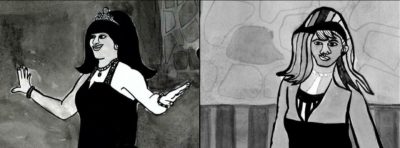

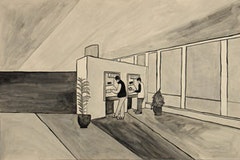

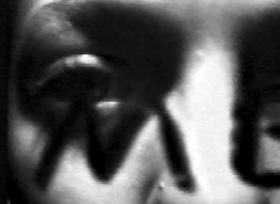

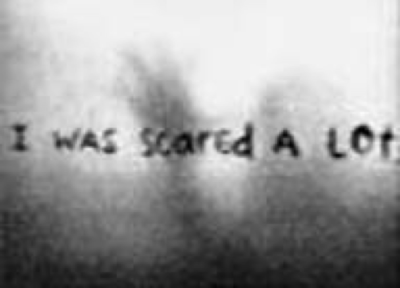


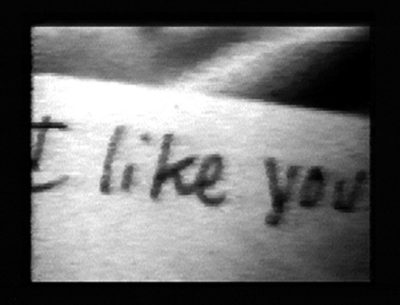
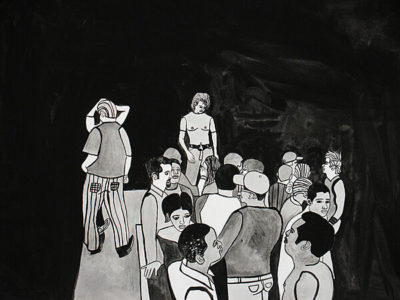


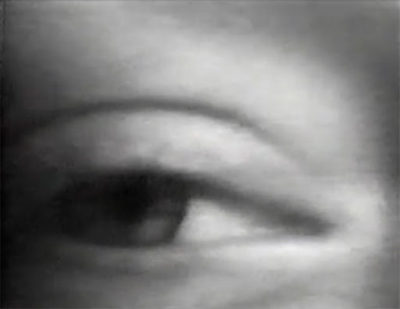
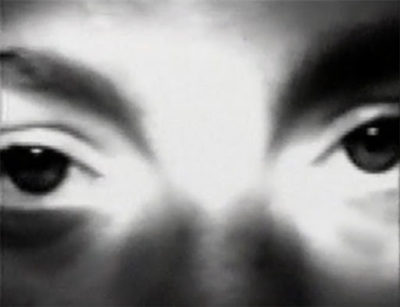




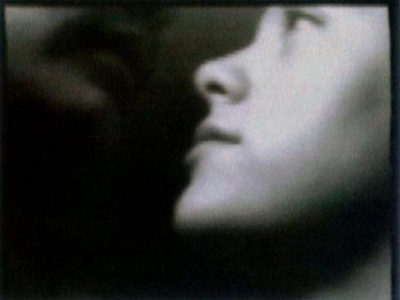
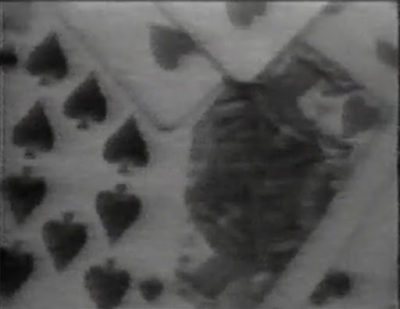
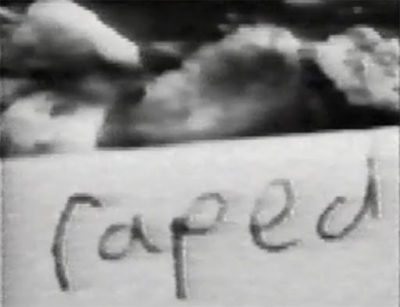

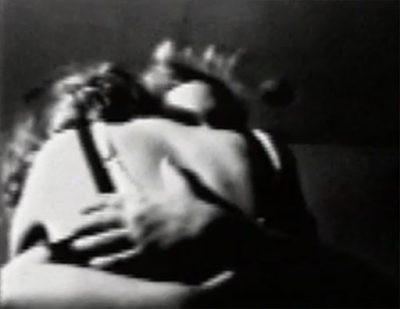


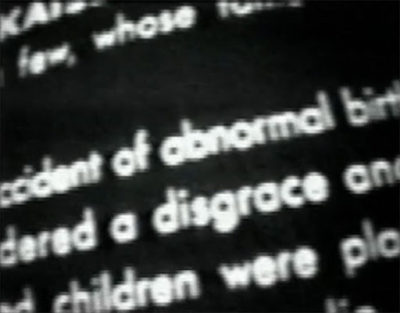


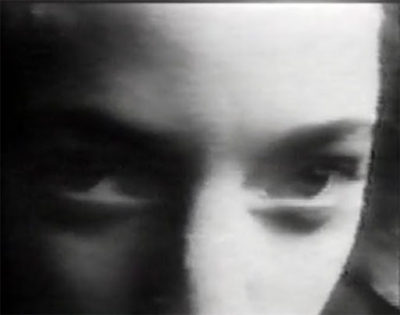
____
Further
Sadie Benning @ Video Data Bank
Sadie Benning @ VIELMETTER LOS ANGELES
Sadie Benning: War Credits
Sadie Benning @ New Media Art
SB @ IMBd
Sadie Benning @ Frieze
Audio: Sadie Benning in Conversation with Lynne Cooke
Sadie Benning’s Top Ten @ Artforum
Sadie Benning @ senses of cinema
Sadie Benning by Linda Yablonsky
Transgender Artist Sadie Benning Is Not Afraid
Sadie Benning: Play Pause
Sadie Benning @ MUBI
Psychic Portraits by Sadie Benning
Sadie Benning : mon esprit, mon œil!
Sadie Benning or the Secret Annex
Dumb Material and Animate Belief: Sadie Benning Plays (with) God
Audio: Sadie Benning and Kim McCarty
____
Extras
Sadie Benning Artist Talk
A biographical video on Sadie Benning using her style and medium.
Sadie Benning performance
_____
Interview

Would you call your first works video diaries? They were, in a way, forerunners to YouTube videos.
I was young and aware of the diary as a format, but I was more conscious that the videos were experimental and performance based–my concern with the word diary is that it highlights the confessional and is less about the imaginative and abstract qualities that I associate with those videos.
Your early videos were a way for you to construct your identity. What was the environment you grew up in?
I grew up in Milwaukee with my mom in a working class and racially mixed neighborhood in the 1980’s. [Benning’s parents were divorced.] The neighborhood had problems with unemployment, drugs, gangs and police profiling, and yet it was also the place I grew up in, a place where you had friends and family. So I saw it not in terms of only the bad but in terms of its beauty, too. I remember kids in my neighborhood not being sure how to read my gender identity so they would tease me by calling me Michael Jackson, which was strange at the time, but also I loved Michael Jackson so I was cool with it, too.
In those pre-Internet days, you had to mail or hand-deliver your videos. Is there anything you miss about that mode of delivery?
All my videos were distributed through the mail and most of them still are, by the Video Data Bank at The School of the Art Institute of Chicago. It was very analogue. In a way, I got to understand what audience means to me by having to be there physically at screenings. This is a very different mode of distribution than the internet, or say YouTube. But I still am so informed by this way of thinking that I don’t miss it yet. I can’t miss it because I’m still doing it.
In the 1990s, you joined forces with Bikini Kill’s Katheen Hanna to form Le Tigre.What was appealing to you about being part of a band?
I’m from a family where making music is part of one’s everyday experience, so it was natural to me to be in a band with friends. I think music is a place where you can challenge social conventions because rhythm is so personal. It makes you feel things. I think that musical influences and the experience of creating music is in everything I do. It’s like a heartbeat.
You’ve said that since you didn’t train as a painter, you feel more freedom about what you can and can’t put in a painting. How so?
I just feel less inhibited as to what is acceptable. The history of painting is heavy with arguments, and as much as I am interested in knowing about them conceptually, I don’t want to feel oppressed in the studio. I want to be free to try things that don’t make sense yet. I put materials together that maybe shouldn’t be and don’t follow hierarchies. I don’t privilege the painting over the drawing—the drawing is the painting and because I’m less versed on the history of painting, I’m less concerned with if it even is a painting.
What are you exploring in your new show, “Green God”? Green naturally has lots of associations as does that other word in your title.
I was interested in thinking associatively about inherited belief systems and contradictions, especially in relation to capitalism and religion. I was interested in what the contradictions are in the signifiers for the color green—green being the color of money in the U.S., the color of envy or jealousy, and also a symbol for nature while being used by a corporation like British Petroleum to convey a sense of being environmentally sound. And I also wanted to think about more diverse representations of what a god can be and look like. The wall of seven associative images at Mary Boone Gallery is a good example of this: Turquoise God, Worm God, Green God, Purple Hat God, Grey God. Spattered connectively throughout this train of images are two paintings “Coin” and “Mayflower Now,” which point to the pilgrims. These were religious separatists who fled England to find freedom, but then they also took freedom and land from the Native Americans who were already living here. I don’t know what to do with the reality of this history as a United States citizen except to see how wrong it is and bring voice to that because it remains politically relevant to me.
How do the two parts of the show—at Mary Boone and Calicoon Fine Arts—connect? Or do they?
The show came about through conversations between myself, [curator] Piper Marshall, Mary Boone and Photi Giovannis. I dealt with the Mary Boone uptown space differently because it has a different aura; her space is particular to her. Mary is a mythic figure—she has a long history and has her own notoriety as a figure so I was well aware of this when imagining showing with her. And I was aware that her space would imbue some of these historic narratives and myths as well. So I wanted to work with the found objects and photographs within that context because they too have had their own lives and aura, a kind of known and unknown presence. At Callicoon Fine Arts on the Lower East Side, I wanted to deal less with the associative links inside each painting and more with the associations between the works themselves.
Tell me about the works combining photography and painting.
I wanted to deal with my own unease about the separateness of medium specificity. The invention of photography was something that was literally a threat to painting as a medium, and it feels unnerving to me somehow to insert one into the other—like a bad idea, or like sitting the wrong people next to one another at dinner. But I like challenging myself to solve a problem and to deal with the uncomfortable.
______________
Sadie Benning’s Videos
______________
Living Inside (1989)
‘When she was 16, Benning stopped going to high school for three weeks and stayed inside with her camera, her TV set, and a pile of dirty laundry. This tape mirrors her psyche during this time. With the image breaking up between edits, the rough quality of this early tape captures Benning’s sense of isolation and sadness, her retreat from the world. As such, Living Inside is the confession of a chronic outsider.’ –– Quentin Roosevelt
the entirety
______________
A New Year (1989)
‘In a version of the “teenage diary,” Benning places her feelings of confusion and depression alongside grisly tales from tabloid headlines and brutal events in her neighborhood. The difficulty of finding a positive identity for oneself in a world filled with violence is starkly revealed by Benning’s youthful but already despairing voice.’ — vdb

______________
If Every Girl Had a Diary (1990)
‘Setting her pixelvision camera on herself and her room, Benning searches for a sense of identity and respect as a woman and a lesbian. Acting alternately as confessor and accuser, the camera captures Benning’s anger and frustration at feeling trapped by social prejudices.’ — vdb
Excerpt
______________
Me and Rubyfruit (1990)
‘Based on a novel by Rita Mae Brown, Me and Rubyfruit chronicles the enchantment of teenage lesbian love against a backdrop of pornographic images and phone sex ads. Benning portrays the innocence of female romance and the taboo prospect of female marriage.’ — vdb
Excerpt
_____________
Jollies (1990)
‘Jollies relates one-by-one the episodes in Sadie Benning’s love life that led her to suspect and then realise that she was homosexual. The film begins with a picture of two Barbie dolls, side by side, intersected by a large close-up of an open mouth with teeth clamped in a brace. This is a child’s mouth, that of the producer who begins to tell the story of her first sexual experience at the age of 12 with a 16-year old boy; she touched his private parts to win a bet. Photographs of twin girls and shots of Sadie Benning, turned at an angle of 90 degrees, alternate with fragments of texts written on sheets of paper and filmed at very close range. When the story of Sadie Benning touching the boy’s private parts is being related, we see a shot of her hands holding a baseball bat with a threatening gesture. The second experience at the age of 15 was to fall in love with a girl. The difficulty of this situation is evidenced by pictures of Sadie covering her face with shaving cream, then pretending to have a shave, as if she had to change into a man in order to be able to love girls. The voice off the screen, however, is lucid, “I’m not a man”. As the story unfolds and the older Sadie becomes, the more she becomes aware of the social and political stakes linked to sexuality and the symbol of this awareness is the sequence where the text is written on bank notes. The story ends with an observation pitched somewhere between bitterness and irony, “I found I was as queer as can be”.’ — LLH
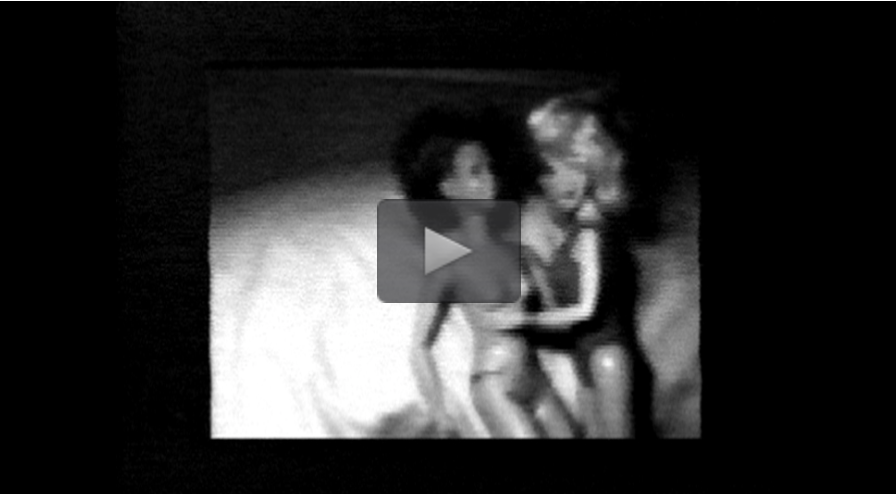
______________
A Place Called Lovely (1991)
‘“Nicky is seven. His parents are older and meaner.” A Place Called Lovely references the types of violence individuals find in life, from actual beatings, accidents and murders, to the more insidious violence of lies, social expectations, and betrayed faith. Benning collects images of this socially-pervasive violence from a variety of sources, tracing events from childhood: movies, tabloids, children’s games (like mumbledy-peg), personal experiences, and those of others. Throughout, Benning uses small toys as props and examples—handling and controlling them the way we are, in turn, controlled by larger violent forces.’ — vdb
the entirety
______________
It Wasn’t Love (1992)
‘This is a fractured tale of a love affair that is both heartfelt and tongue in cheek funny. Sadie Benning herself poses as various types of stereotypical masculinity and femininity: the rebel, the vamp, the biker, the bimbo. She also reveals the frustration of her position as a teenage lesbian growing up in Middle America.’ — MELLART

______________
Girl Power (1992)
‘Girl Power shows Benning’s aim to reach a wider audience with her video works. Informed by the “riot grrl” movement of the 1990s, an aggressive underground movement led by young women who espoused female empowerment through art, music, zines, and activism. Girl Power is a collage of sound and black-and-white imagery. The work refuses to visualize female passivity and politeness in favor of a range of views of radicality and rebellion in an amalgam of footage from TV, film, commercials, security cameras, and home movies as well as disturbing scenes of racial violence and homophobic speeches.’ — Landmarks
the entirety
______________
COME “German Song” (1995)
‘Shot in black and white Super 8, this lyrical short follows a wandering, disengaged youth through grey afternoons. German Song features the hard-edged music of Come, an alternative band from Boston.’ — vdb
the entirety
_______________
The Judy Spots (1995)
‘Comprised of five short vignettes about Judy, a troubled teenager made of paper-maché, “The Judy Spots”, were originally brief video ‘spots’ shown on MTV in 1998. When Judy (voiced by Benning) gets depressed she cries, and the sky rains tears, sharing her brief outburst. Judy’s alienation is further experienced at her drive-thru fast food job where she convinces herself she really is a ‘people person’. If she’s such a ‘people person’, why is her fragile psychic state threatening to eclipse her cardboard cut-out milieu? When Judy later has a nightmare, a series of surreal images pass through her head, spill out into her bedroom and eventually seem to pre-empt an argument she has later with her band mate (voiced by Kathleen Hanna best known from the grunge grrrl band Bikini Kill). They fight on the phone and Judy quits the band. In the next ‘spot’ Judy returns to band practice and sings her new song. The band is joined by Barbie groupies who thrash their synthetic hair around. Judy, it seems, triumphs on stage and screen.’ — showpony
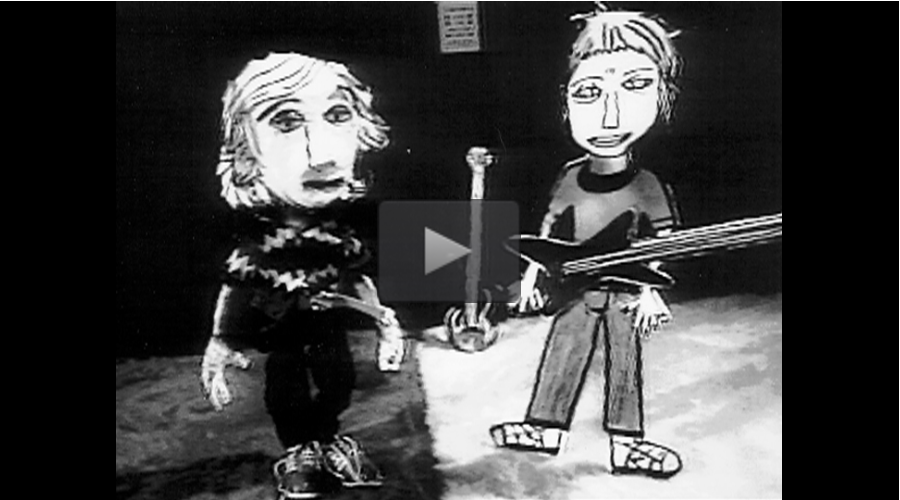
______________
Flat is Beautiful (1998)
‘While developing his ideas around typage and non-actors, Eisenstein often looked back to earlier theatrical traditions, and in particular to the use of masks, performances based “not on the revelation of character but on the treatment of it, because a person comes on with a defined character passport.” Sadie Benning’s Flat Is Beautiful centers on a melancholy tween tomboy grappling with their gender identity in working-class Milwaukee. Rendered in Super-8 and Pixelvision, Benning’s oneirically lo-fi featurette plays like the strangest after-school special ever made, a brilliant exploration of the ways inner life can—or cannot—be read across a frozen face, in which every member of the cast sports a different paper, hand-drawn visage.’ — Filmlinc

______________
Julie Ruin “Aerobicide” (1998)
‘This music video for the band Julie Ruin, fronted by Kathleen Hanna, formerly of Bikini Kill, critiques the cynical music marketeers of corporate America. Criticism particularly targets campaigns aimed at women, which Benning and Hanna refer to here as the “Girls Rule (kind of) Strategy.”‘ — vdb
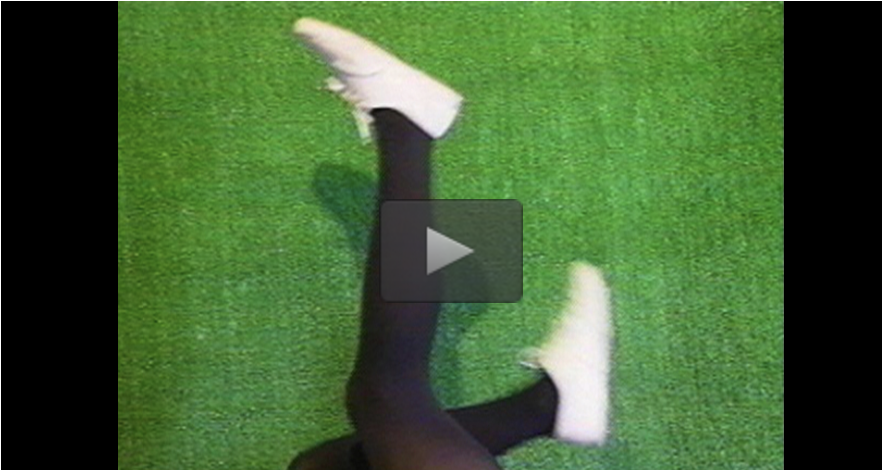
_______________
Play Pause (2006)
‘Play Pause differs in many ways from Benning’s well-known single-channel videos from the 1990s. Departing from her intensely personal, coming-of-age teenage works, this two-screen projected video installation, directed in collaboration with Solveig Nelson, comprises hundreds of drawings that weave in and out of public and private urban spaces. In the post-9/11 world depicted here, wars rage in the headlines and malfunctioning Diebold ATMs fail to provide receipts.
‘The video spans a day in an anonymous city suggestive of Chicago. Commuters on the train, workers digging up the street and a game of soccer give way to drinking, dancing and sex. The video’s cycle slows to an end at dawn in an airport: a figure, neither distinctly male nor female, approaches the washrooms and hesitates before the two doors; security guards scan bags and faces; and a couple has sex on the wing of a plane as it takes off. Here, in this leaping between anonymous figures in the cityscape, the characters in Play Pause are not unlike those in Benning’s earlier videos – isolated, lonely and wandering through the world as they explore and come to terms with their queer identities.’ — The Power Plant
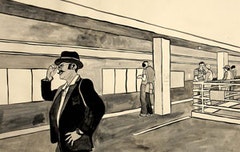
*
p.s. Hey. ** David S. Estornell, You too. ** David Ehrenstein, Morning, sir. ** _Black_Acrylic, Hi, Ben. It held up really well, no? Thank you so much again. Psychedelic horror sounds, you know, kind of heavenly, so keep your nose to the grindstone, man. ** Tosh Berman, I thought I remembered you a Meek dude. Thanks for being here. Happy in-between two holidays to you, sir. ** Jack Skelley, Ah, see, Dee Dee makes sense. I think he lived on Hollywood Blvd. William not James, right. *boing* See you maybe even before you see this. ** Dominik, Hi, D! I’ll figure it out because I literally have no choice, well, unless I’m willing to be a flake, which I’m not. My luck with Buches has been very good over the years, so ending up with one booby trap is okay. We had fun humiliating it. I’m friends with DeAundra Peek on Facebook, or rather DeAundra’s secret identity. I think he has completely retired her now, which is very sad. She was … something else. Ha ha ha, that love aka clip is amazing! If that doesn’t kick my brain into gear, nothing ever will. Love, Dennis. ** schlix, Hi, Uli! At this moment it’s not so bad. Stores are open, but not cafes, restaurants, bars, museums, cinemas, or theaters. 8 pm curfew (even on NYE). So maybe sort of like the situation where you are. But it’s all but completely certain that we’re going to go into serious quarantine again, probably next week because things are getting worse. This whole thing is getting so unbelievably old. Enjoy the nighttime quiet. I’m digging ours as well. ** Misanthrope, I don’t know, watching someone rot away might be even too kinky for my imagination. Not to mention boring. Speaking as someone who likes watching films where nothing happens for hours. Back when I played guitar in my high school rock bands, ‘Louie Louie’ was the first thing I learned to play on guitar. That song is eternal. And eternally easy, probably not coincidentally. Adulthood swallows the best of us eventually. Sadly. ** Steve Erickson, Yeah, He had a vision, that guy. My memory of the original ‘Paul is Dead’ is that it was more of a formal puzzle. I don’t remember Paul actually being dead as being the point. It was more about solving the mystery of whether The Beatles were behind all the many clues in their songs and album covers, etc. or whether all that stuff was an inexplicably complex coincidence. In retrospect, it was kind of like playing a puzzle-based video game but with physical materials IRL. I don’t remember there being any related cults or militias or anything springing up. ** Right. Today the blog devotes itself to the wonderful videos of the great Sadie Benning. Have at it, please. See you tomorrow.




 Now available in North America
Now available in North America 
Great Sadie Benning Day!
Sadie goes where her father James cannot.
Today marks the birthday’s of Marianne Faithfull and Barbara Steele Two Immortal Goddesses.
Dennis, Shoot, I meant to say, too, yesterday that The Mandalorian is good, fun little show. Lot of action and humor in it, and it has a lot of the first films’ themes and mythos and all that. Only 8 episodes per season, so not a struggle to get through at one time. A nice little diversion/distraction.
It is fun to play something on the guitar and recognize it, you know? Probably part of the appeal of “Louie Louie,” too. I’m just in my third month of learning the instrument, so it’s fun to hear something recognizable, however horribly played, coming out of the amp.
I’ve found a bunch of little YouTube accounts where they teach the easy songs, so that’s a good diversion from the Fender Play subscription lessons that I’m doing.
Kinda hate some of these instructors in those lessons too. Like, they’re not very detailed. Just “do this, this, and that” and no detail, like it’s shit I should just know. But I have time and go over things (or just skip them, mwahahahaha!).
Sadie Benning was a new name to me and I will catch up on her oeuvre over the coming week. That interview shows her to be a pioneer in a lot of ways. Her show at Camden Arts Centre in 2018 looked good so I will try and catch up on that online too.
RIP Pierre Cardin, what will become of Sade’s castle now?
Hi!!
I’m not familiar with Sadie Benning, but as I started exploring their videos now, I found that they really touched me. They resonate with me deeply. I love their atmosphere and sensitivity. Thank you so much for this post!
It’s funny, but I really like DeAundra’s voice, haha. And yeah, she’s definitely something else. She’s got some memorable performances. Her “Deeper and Deeper” Madonna cover is kind of golden. It’s sad that she’s retired now.
Haha, this love made me laugh out loud. Love like him: https://www.instagram.com/p/B9Z18iaJOgV/
Excellent Sadie Benning post today. Those early videos are incredibly great!
Dennis, thanks! We’ve been doing okay, thanks, too. Pretty much the same all year, except the kiddo went back to school in fall but my university work stayed online. I don’t go out much, except to the park. Yes, things were seeming to open up for a while to more movement and travel but that’s all ground to a halt for now too. Still, probably way better than a lot of places. I’ve been chipping away at several things. My j-novel, another possible novel, and other short pieces. One for an Expat anthology coming in the new year, edited in part by local great James Nulick. And one for the Infinity Land anthology. I meant to finish a post for you about the Setagaya Murders, but got slowed down with work stuff. It’s actually 20 years today (30 Dec 2000) that it happened. The police and council want to demolish the place, but the sister’s been trying to save it. Here’s to 2021!
I wondered why Benning stopped making films and didn’t know she’d become a painter.
YouTuber Quinton Reviews made a pretty good half hour video essay arguing for “Paul is Dead” as the start of the modern conspiracy theory era (although the JFK assassination, which he also brings up, makes more sense.) I’ve always found the “a secret organization is taking over the world but they left us cryptic clues to piece together” mentality behind conspiracy theories odd but amazing. If the Freemasons really ran the world, they would probably not be telling Jay-Z to use their symbols in his music videos.
Hey Dennis – Enjoyed this Sadie Benning day. I know and like her early videos, but I didn’t know what she’d been up to since leaving Le Tigre. I was lucky to see them with her and thought they lost a step musically once she departed. Her new work looks really interesting.
Are you familiar with Susan Hiller’s art? Partly performance based, but more installations often using found objects. I ran across her stuff online a few months ago and seem to be developing a small obsession.
If yr ears were burning, I spoke with Michael Silverblatt the other day and many nice things were said about you. He asked me to pass along how much he misses you.
We should catch up via Skype sometime soon. Later next week maybe?